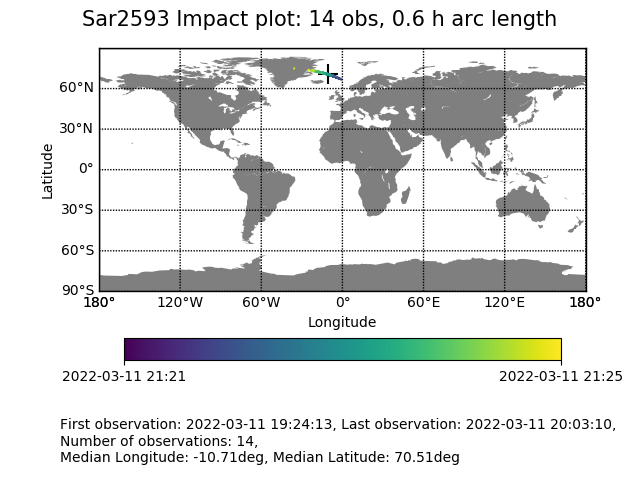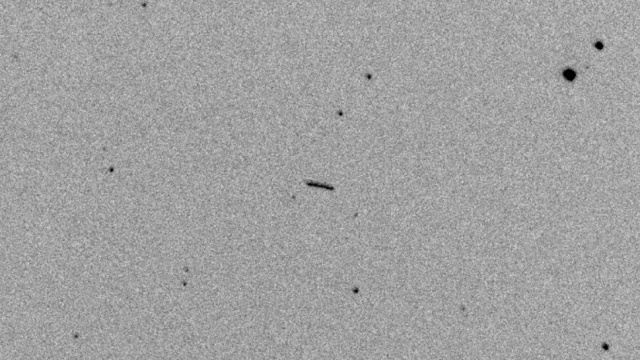An asteroid measuring around 3.05 m wide has burnt up in the skies north of Iceland. This sort of thing happens from time to time, but this incident was notable in that the asteroid was spotted less two hours before the impact.
Krisztián Sárneczky gets credit for the discovery, as the Hungarian astronomer spied the rock with a 60-centimetre telescope at the Piszkéstető observatory, according to the European Space Agency. His initial observation came at 6:24 a.m. AEDT on March 12, 2022. A total of four observations were made of the bright, fast-moving object before Sárneczky reported his finding to the Minor Planet Centre, which he did less than 15 minutes after the first sighting.
Informed of the object’s existence, the MPC named it Sar2593. The centre’s assessment systems churned out an impact probability at less than 1%, but Krisztián kept going, performing another 10 observations of the object while keeping in close contact with the MPC. The new influx of data produced a different result; one hour after Sárneczky’s initial sighting, the ESA’s Meerkat monitoring system issued an alert to the agency’s Near-Earth Object Coordination Centre (NEOCC), as the probability of impact was upped to 100%.
What’s more, the calculations showed that the inevitable impact would happen in less than an hour, between 8:21 and 8:25 p.m. AEDT, and that the object would enter Earth’s atmosphere a few hundred miles north of Iceland. The incoming asteroid was not deemed a threat, as its brightness pointed to a rock no larger than 1 metre in diameter (this turned out to be an underestimate — more on this in just a bit). Objects that small don’t tend to survive entry through the atmosphere, and roughly 10 asteroids of this size reach our planet each year.
The Meerkat alert prompted other astronomers to take a look, resulting in a slew of new observations, including viewings from an observatory in Kysuce, Slovakia. The new data resulted in an even more precise prediction of where it would enter Earth: roughly 140 km south of Jan Mayen, an Arctic island located 1,910 km northeast of Iceland. And at 8:22 am AEDT, it would strike Earth “less than two hours after being discovered,” according to ESA. No video or images were taken of the corresponding fireball, but infrasound detectors definitely noticed an anomaly.

“Signals from the impact were detected from Iceland and Greenland, suggesting an energy release equivalent to 2 to 3 [kilotons] of TNT,” according to NEOCC. That’s more than what would’ve been expected from a 0.91 m-long object, and a sign that it was likely around 3 to 4 metres in diameter. “The discrepancy is likely the result of the measurement uncertainties in both the optical observations and the infrasound detections,” NEOCC added.
The 2 to 3 kilotons of released energy is nothing to cough at. That’s nearly one-fifth of the energy released by the atomic bomb detonated over Hiroshima. Still, it doesn’t compare to the meteor that disintegrated over Chelyabinsk, Russia, in 2013. That superbolide released somewhere around the equivalent of 460 kilotons of TNT.
MPC renamed the object 2022 EB5, as it had earned the distinction of being just the fifth known asteroid to be observed in space prior to hitting our planet. Detecting objects larger than a mile wide is obviously much easier than spotting objects the size of this one, but this incident suggests we’re getting better at doing exactly that, as all five of these detections were made in the past 14 years.
More tools to detect these sorts of objects are clearly necessary, whether to warn against blasts that can shatter windows or impacts of an existential scale. To that end, NASA recently deployed an upgraded version of its impact monitoring system, while also launching the Double Asteroid Redirect Test (DART), in which a spacecraft will attempt to deflect a tiny asteroid called Dimorphos. ESA is also doing its part, as the agency is set to build the Flyeye telescope in Italy. The upcoming telescope will enable astronomers to cover more sky at night and “reduce the chance that we miss any interesting object,” as Detlef Koschny, ESA’s acting Head of Planetary Defence, explained in the ESA statement.
Indeed, we’re getting there — one pesky asteroid at a time.
